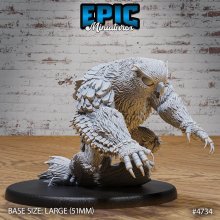[Large Sized Model - 50mm Base]
[Presupported in 32mm scale]
A distinct breed of Owlbear native to the mountains and valleys of northern Draksborne and southern Karkanoth, these creatures are remarked for their unique flat faces, resembling masks. Elves native to the region call them Moon Owlbears, owing to their face resembling a crescent moon. These Owlbears however are some of the deadliest on Tharador, and are responsible for dozens of deaths every year, able to easily gore a whole squad of unprepared soldiers.
In the rugged expanse of northern Draksborne and the southern reaches of Karkanoth, there exists a remarkable species of creature that captures the awe and fear of those who know of its presence: the Northern Masked Owlbear. Distinguished from its kin by a unique facial structure, these owlbears boast flat, mask-like faces, an adaptation that has earned them the moniker "Moon Owlbears" among the local elven populations. This name is inspired by their visage, which bears a striking resemblance to a crescent moon, casting an eerie, otherworldly silhouette against the backdrop of their mountainous homes.
Despite their captivating appearance, the Northern Masked Owlbears are among Tharador's most formidable predators. Their reputation for lethality is well-founded, with numerous accounts of these creatures decimating entire groups of adventurers or soldiers with terrifying efficiency. Their formidable claws and beaks, combined with a surprising agility for their size, allow them to tackle prey much larger than themselves, making them a dire threat to the unprepared or unwary.
These owlbears' territories span the dense forests and craggy slopes of the north, where they reside in secluded dens. They are most active under the cover of night, using the darkness to their advantage to ambush prey. The Northern Masked Owlbear's predation patterns play a significant role in the ecosystem, influencing the behaviour of other species and the structure of the local wildlife community. Despite the danger they pose, these creatures remain an object of fascination and study for naturalists and scholars, eager to understand more about their unique adaptations and the role they play in Tharador's rich tapestry of life.











